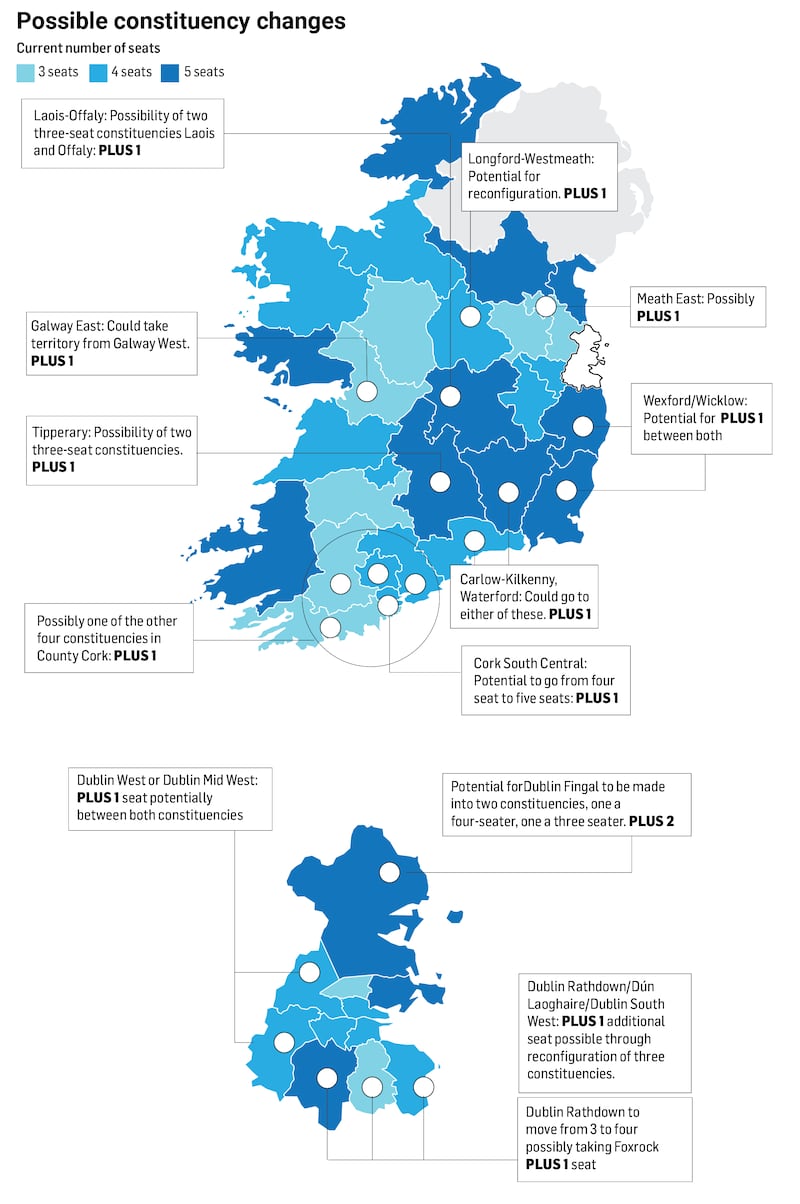Dublin is the cockpit of general elections, accounting for almost a third of all TDs.
The city’s population has grown on average by 8 per cent since 2016, exceeding 10 per cent in three constituencies. Dublin is likely to receive as many as six more seats, spread across its 11 constituencies, based on the recommendations of the Electoral Commission in its review published next week.
That means the total number of TDs in Dublin could rise from 45 to above 50. But with neighbouring constituencies such as with two in Meath, Louth, two in Kildare and Wicklow also recording strong population growth, the political and electoral importance of the east coast region will continue to grow.
So, there will be extra seats all around the city and suburbs – but where? Well, the options are endless.
RM Block
The three seater-constituency of Dublin-Rathdown – where all the TDs are Ministers and all are nervous of losing their seat to a Sinn Féin challenger – could gain an extra seat, though this would likely require a transfer of some areas from Dún Laoghaire. Alternatively, Dún Laoghaire could be enlarged to a five-seater from four currently.
Similarly, either Dublin South-Central or Dublin Bay South are likely to receive an extra seat, with one transferring some areas to the other. An extra seat would ease the pressure on the high-profile Bay South TDs – Labour’s Ivana Bacik, Fianna Fáil’s Jim O’Callaghan and Green leader Eamon Ryan (Sinn Féin’s Chris Andrews is probably safe) – from a strong Fine Gael challenge in a traditional stronghold where it currently has no seat. Either Dublin South-West or Dublin Mid-West should also receive an extra seat.
More seats are expected to be added across the northside constituencies of Dublin Bay North, Fingal, Dublin West and Dublin Central but because Bay North and Fingal are already five-seaters, either substantial rejigging of boundaries will be required or a new constituency created, with Fingal split into two three-seaters. Political geographer Adrian Kavanagh has suggested the possible creation of a new constituency centred on the town of Swords.

The submissions by the various parties to the Electoral Commission go into considerable detail about their preferred outcomes, advising various changes across the city and suburbs, most of which they think would be to their advantage. The Labour Party, for example, suggests three-seaters should be removed completely. In general, five seaters – Labour reckons these should be the norm in the capital – give smaller parties a better chance of winning seats. The Greens argue for six-seaters, though that’s outside the scope of the current review. Everyone has their own angle.
These decisions will have a direct bearing on the chances of individual candidates. While their strength matters hugely, it’s hard to buck national trends in party support. Look at it this way: in a five-seater, a quota is 16.7 per cent; get 10 per cent of the vote and you’re in with a shout.
Sometimes a lot less will do; in Dublin Fingal at the last election, Labour’s Duncan Smith won just 7 per cent of first preferences and won a seat. In a three-seater, the quota is 25 per cent. Very few people with 10 per cent get elected. Nobody with 7 per cent does.
The areas transferred between constituencies can often also be crucial. At the last boundary revision, the then Constituency Commission directed that Dublin Central (previously a three-seater) become a four-seater, transferring four electoral divisions, and over 12,000 voters, from the adjoining constituency Dublin North-West to Central.
Fine Gael TD Noel Rock was aghast, complaining that he had lost “20 per cent of my voters at the stroke of a pen”. His party colleague Paschal Donohoe in Dublin Central, on the other hand, was delighted to welcome more Fine Gael voters to his constituency where he would have faced an uphill task to hold on had it remained a three-seater. Rock lost his seat; Donohoe kept his.













